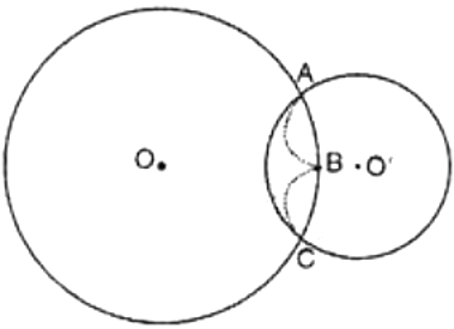Ask questions which are clear, concise and easy to understand.
Ask QuestionPosted by Vaibhav Pandey 2 years, 11 months ago
- 1 answers
Posted by Saswat Singh 2 years, 11 months ago
- 1 answers
Preeti Dabral 2 years, 11 months ago
Inner diameter of bowl = 10.5 cm
{tex}\therefore {/tex} Inner radius of bowl {tex}\left( r \right)=\frac{10.5}{2}{/tex} = 5.25 cm
Now, Inner surface area of bowl = {tex}2\pi {{r}^{2}}{/tex}
{tex}=2\times \frac{22}{7}\times 5.25\times 5.25{/tex}
{tex}=2\times \frac{22}{7}\times \frac{21}{4}\times \frac{21}{4}{/tex}
={tex}\frac{693}{4}c{{m}^{2}}{/tex}
{tex}\because {/tex} Cost of tin-plating per{tex} 100\text{ }c{{m}^{2}}{/tex} = ₹ 16
{tex}\therefore {/tex} Cost of tin-plating per{tex} 1\text{ }c{{m}^{2}}=\frac{16}{100}{/tex}
{tex}\therefore {/tex} Cost of tin-plating per {tex}\frac{693}{4}c{{m}^{2}}=\frac{16}{100}\times \frac{693}{4}{/tex} = ₹27.72
Posted by Tanisha Singh 2 years, 11 months ago
- 4 answers
Posted by Dilpreet Kaur 2 years, 11 months ago
- 0 answers
Posted by Nishit Agarwal 2 years, 11 months ago
- 1 answers
Preeti Dabral 2 years, 11 months ago
- (b) 120°
- (a) 60°
- (c) 180°
- (d) {tex}\angle{/tex}q
- (a) 60°
Posted by Jatin Aggarwal 9Th D 3 years ago
- 4 answers
Anvi 8A Arnav Singh11 2 years, 11 months ago
Posted by Total Game Fire 3 years ago
- 4 answers
Posted by Yashvi Stu 3 years ago
- 1 answers
Posted by Aaisha Rabia Shabuddin 3 years ago
- 1 answers
Preeti Dabral 3 years ago
{tex}\begin{aligned} & \Longrightarrow \frac{2 \sqrt{6}}{\sqrt{2}+\sqrt{3}} \times \frac{\sqrt{2}-\sqrt{3}}{\sqrt{2}-\sqrt{3}}+\frac{6 \sqrt{2}}{\sqrt{6}+\sqrt{3}} \times \frac{\sqrt{6}-\sqrt{3}}{\sqrt{6}-\sqrt{3}}-\frac{8 \sqrt{3}}{\sqrt{6}+\sqrt{2}} \times \frac{\sqrt{6}-\sqrt{2}}{\sqrt{6}-\sqrt{2}} \\ & \Longrightarrow \frac{4 \sqrt{3}-6 \sqrt{2}}{2-3}+\frac{12 \sqrt{3}-6 \sqrt{6}}{6-3}-\frac{24 \sqrt{2}-8 \sqrt{6}}{6-2} \\ & \Longrightarrow-4 \sqrt{3}+6 \sqrt{2}+\frac{12 \sqrt{3}-6 \sqrt{6}}{3}-\frac{24 \sqrt{2}-8 \sqrt{6}}{4} \\ & \Longrightarrow-4 \sqrt{3}+6 \sqrt{2}+4 \sqrt{3}-2 \sqrt{6}-6 \sqrt{2}+2 \sqrt{6} \\ & \Longrightarrow-4 \sqrt{3}+6 \sqrt{2}+4 \sqrt{3}-2 \sqrt{6}-6 \sqrt{2}+2 \sqrt{6} \\ & \Longrightarrow 0 \end{aligned}{/tex}
Posted by Ujjwal Thakur 3 years ago
- 0 answers
Posted by Ayisha A 3 years ago
- 1 answers
Aryan Chauhan 3 years ago
Posted by Ashutosh Yadav 3 years ago
- 1 answers
Posted by S. Kolvalai 3 years ago
- 2 answers
Preeti Dabral 3 years ago
SAS congruence criterion: If two sides and included an angle of one triangle are equal to the corresponding two sides and included angle of another triangle then the two triangles are said to be congruent.

Consider {tex}\triangle{/tex}ABC, {tex}\triangle{/tex}PQR
here AB = PQ, AC = PR and {tex}\angle{/tex}A = {tex}\angle{/tex}P
Hence {tex}\triangle{/tex}ABC {tex}\cong{/tex} {tex}\triangle{/tex}PQR by SAS congruence criterion.
Posted by Yogesh Shekhadar 3 years ago
- 1 answers
Posted by Sumedh Wani 3 years ago
- 1 answers
Posted by Harini Murugan Harini 3 years ago
- 1 answers
Preeti Dabral 3 years ago
For class room : l = 7m, b = 6.5 m, h = 4 m
∴ Area of walls of the room = 2(l + b)h = 2(7 + 6.5)4 = 108 m2
Area of door = 3 × 1.4 = 4.2 m2
Area of one window = 2 × 1 = 2 m2
∴ Area of 3 windows = 3 × 2 = 6 m2
∴ Area of the walls of the room to be colour washed = 108 – (4.2 + 6)
= 108 – 10.2 = 97.8 m2
∴ Cost of colour washing the classroom at Rs. 15 per square metre = Rs 97.8 × 15 = Rs. 1467.
Posted by Sakshi Jaiswal 3 years ago
- 1 answers
Preeti Dabral 3 years ago
Constructing triangle ABC in which AB = 5.8 cm , BC + CA = 8.4 cm and ∠B = 45°.
Step 1: Draw a line segment AB 5.8 cm.
Step 2 : Draw ∠B = 45°.
Step 3 : With Center B and radius 8.4 cm, make an arc which intersects BX at D.
Step 4 : Join D to A.
Step 5 : Draw a perpendicular bisector of segment DA it intersect the line segment BD at point C.
Step 6 : Join C to A.
ABC is the required triangle.
Posted by Archita Singh 3 years ago
- 2 answers
Posted by Rishika Minj 3 years ago
- 1 answers
Posted by Aashika Bi 3 years ago
- 1 answers
Preeti Dabral 3 years ago
Since we know that rational number between two rational numbers is obtained by {tex}\frac{1}{2}{/tex}[a+b]
A rational number lying between -2 and -3 is {tex}\frac{1}{2}{/tex}[(-2) + (-3)],
i.e.,{tex}-\frac{5}{2}{/tex}
Now, a rational number lying between -2 and{tex}-\frac{5}{2}{/tex}is
{tex}\left.\frac{1}{2}[(-2)+\left(-\frac{5}{2}\right)\right ]{/tex}
= {tex} \frac{1}{2} \times\left(-\frac{9}{2}\right) {/tex}
= {tex}-\frac{9}{4} {/tex}
And, a rational number lying between {tex}-\frac{5}{2}{/tex} and -3 is
{tex}\frac{1}{2}\left(\left(-\frac{5}{2}\right)+(-3)\right) {/tex}
{tex}\frac{1}{2} \times\left(-\frac{11}{2}\right){/tex}
{tex}-\frac{11}{4} {/tex}
Thus, we have {tex}-2>-\frac{9}{4}>-\frac{5}{2}>-\frac{11}{4}>3{/tex}
Hence, three rational numbers between -2 and -3 are {tex}-\frac{9}{4},-\frac{5}{2}{/tex} and {tex}-\frac{11}{4}{/tex}
Posted by Mukund Vishwakarma 3 years ago
- 1 answers
Posted by Bonty Clock Gaming 3 years ago
- 1 answers
Preeti Dabral 3 years ago
From the figure, we observe that when different pairs of circles are drawn, each pair have two points (say A and B) in common.
Maximum number of common points are two in number.

Suppose two circles C (O) and C (O’) intersect each other in three points, say A, B and C.
Then A, B and C are non-collinear points.
We know that:
There is one and only one circle passing through three non-collinear points.
Therefore, a unique circle passes through A, B and C.
{tex} \Rightarrow {/tex} O’ coincides with O and s = r where s and r are the radii of two circles C(O) and C(O')
A contradiction to the fact that C (O’,) {tex} \ne {/tex} C (O,)
{tex}\therefore {/tex} Our supposition is wrong.
Hence two different circles cannot intersect each other at more than two points.
Posted by Ashita Tamang 3 years ago
- 2 answers
Posted by Yash Kaur 3 years ago
- 1 answers
Preeti Dabral 3 years ago
- Surface area of the sphere ={tex}4\pi r^2{/tex}
- For cylinder
Radius of the base = r
Height = 2r
{tex}\therefore{/tex} Curved surface area of the cylinder = {tex}2\pi rh=2\pi (r)(2r)=4\pi r^2{/tex} - Ratio of the areas obtained in (i) and (ii)
{tex}={{surface\ area\ of\ the\ sphere}\over{curved\ surface\ area\ of\ the\ cylinder}}{/tex}
{tex}={{4\pi r^2}\over{4\pi r^2}}={1\over1}=1:1{/tex}

myCBSEguide
Trusted by 1 Crore+ Students

Test Generator
Create papers online. It's FREE.

CUET Mock Tests
75,000+ questions to practice only on myCBSEguide app
 myCBSEguide
myCBSEguide
Preeti Dabral 2 years, 11 months ago
Therefore, 3√4 is greater.
0Thank You